check engine CHRYSLER 200 2013 1.G Owner's Manual
[x] Cancel search | Manufacturer: CHRYSLER, Model Year: 2013, Model line: 200, Model: CHRYSLER 200 2013 1.GPages: 517, PDF Size: 3.4 MB
Page 445 of 517
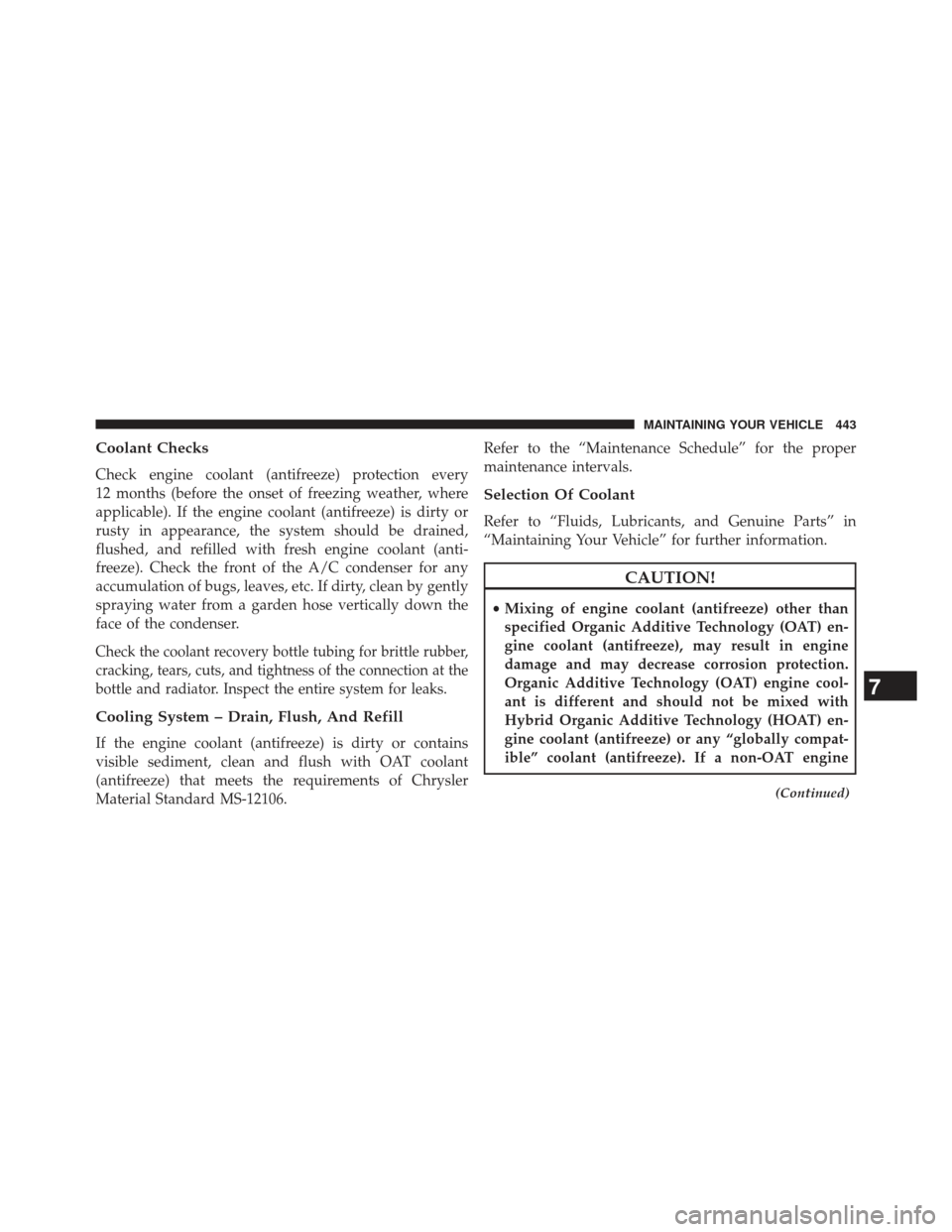
Coolant Checks
Check engine coolant (antifreeze) protection every
12 months (before the onset of freezing weather, where
applicable). If the engine coolant (antifreeze) is dirty or
rusty in appearance, the system should be drained,
flushed, and refilled with fresh engine coolant (anti-
freeze). Check the front of the A/C condenser for any
accumulation of bugs, leaves, etc. If dirty, clean by gently
spraying water from a garden hose vertically down the
face of the condenser.
Check the coolant recovery bottle tubing for brittle rubber,
cracking, tears, cuts, and tightness of the connection at the
bottle and radiator. Inspect the entire system for leaks.
Cooling System – Drain, Flush, And Refill
If the engine coolant (antifreeze) is dirty or contains
visible sediment, clean and flush with OAT coolant
(antifreeze) that meets the requirements of Chrysler
Material Standard MS-12106.Refer to the “Maintenance Schedule” for the proper
maintenance intervals.
Selection Of Coolant
Refer to “Fluids, Lubricants, and Genuine Parts” in
“Maintaining Your Vehicle” for further information.
CAUTION!
•
Mixing of engine coolant (antifreeze) other than
specified Organic Additive Technology (OAT) en-
gine coolant (antifreeze), may result in engine
damage and may decrease corrosion protection.
Organic Additive Technology (OAT) engine cool-
ant is different and should not be mixed with
Hybrid Organic Additive Technology (HOAT) en-
gine coolant (antifreeze) or any “globally compat-
ible” coolant (antifreeze). If a non-OAT engine
(Continued)
7
MAINTAINING YOUR VEHICLE 443
Page 448 of 517

WARNING!
•The warning words “DO NOT OPEN HOT” on the
cooling system pressure cap are a safety precaution.
Never add engine coolant (antifreeze) when the
engine is overheated. Do not loosen or remove the
cap to cool an overheated engine. Heat causes pres-
sure to build up in the cooling system. To prevent
scalding or injury, do not remove the pressure cap
while the system is hot or under pressure.
• Do not use a pressure cap other than the one
specified for your vehicle. Personal injury or en-
gine damage may result.
Disposal Of Used Engine Coolant
Used ethylene glycol-based engine coolant (antifreeze) is
a regulated substance requiring proper disposal. Check
with your local authorities to determine the disposal
rules for your community. To prevent ingestion by ani-
mals or children, do not store ethylene glycol-based
engine coolant in open containers or allow it to remain in
puddles on the ground. If ingested by a child or pet, seek
emergency assistance immediately. Clean up any ground
spills immediately.
Coolant Level
Four-Cylinder Engines – the coolant bottle provides a
quick visual method for determining that the engine
coolant (antifreeze) level is adequate. With the engine
idling and warm to normal operating temperature, the
level of the engine coolant (antifreeze) in the bottle
should be between the “ADD” and “FULL” lines, shown
on the bottle.
446 MAINTAINING YOUR VEHICLE
Page 449 of 517

Six-Cylinder Engines –the level of the engine coolant
(antifreeze) in the pressurized coolant bottle should be
between the “COLD” and “FULL” range on the bottle
when the engine is cold.
The radiator normally remains completely full, so there is
no need to remove the radiator cap unless checking for
engine coolant (antifreeze) freeze point or replacing cool-
ant. Advise your service attendant of this. As long as the
engine operating temperature is satisfactory, the coolant
bottle need only be checked once a month. When addi-
tional engine coolant (antifreeze) is needed to maintain
the proper level, it should be added to the coolant bottle.
Do not overfill.Points To Remember
NOTE: When the vehicle is stopped after a few miles/
kilometers of operation, you may observe vapor coming
from the front of the engine compartment. This is nor-
mally a result of moisture from rain, snow, or high
humidity accumulating on the radiator and being vapor-
ized when the thermostat opens, allowing hot engine
coolant (antifreeze) to enter the radiator.
If an examination of your engine compartment shows no
evidence of radiator or hose leaks, the vehicle may be
safely driven. The vapor will soon dissipate.
• Do not overfill the coolant expansion bottle.
• Check the coolant freeze point in the radiator and in
the coolant expansion bottle. If engine coolant (anti-
freeze) needs to be added, the contents of the coolant
expansion bottle must also be protected against
freezing.
7
MAINTAINING YOUR VEHICLE 447
Page 453 of 517
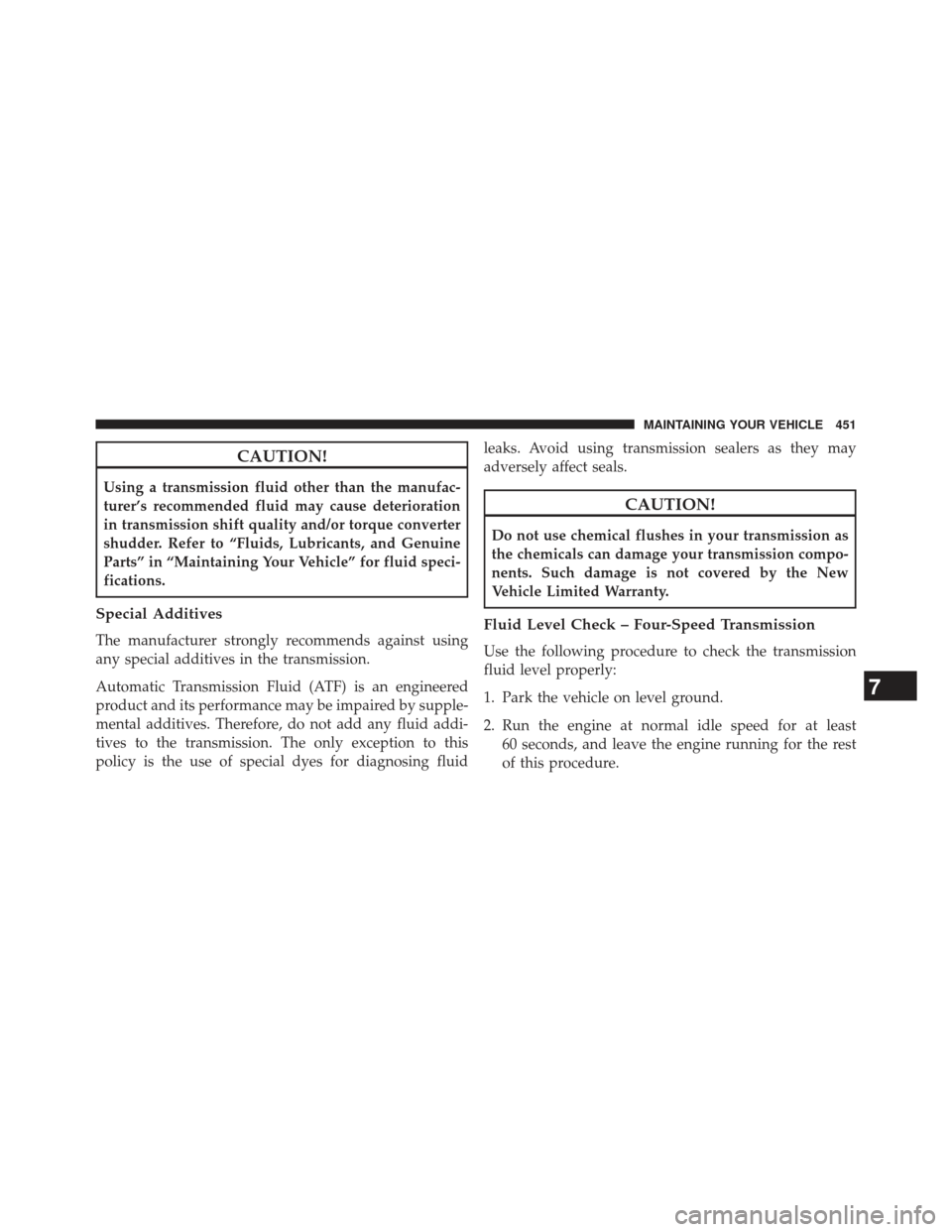
CAUTION!
Using a transmission fluid other than the manufac-
turer’s recommended fluid may cause deterioration
in transmission shift quality and/or torque converter
shudder. Refer to “Fluids, Lubricants, and Genuine
Parts” in “Maintaining Your Vehicle” for fluid speci-
fications.
Special Additives
The manufacturer strongly recommends against using
any special additives in the transmission.
Automatic Transmission Fluid (ATF) is an engineered
product and its performance may be impaired by supple-
mental additives. Therefore, do not add any fluid addi-
tives to the transmission. The only exception to this
policy is the use of special dyes for diagnosing fluidleaks. Avoid using transmission sealers as they may
adversely affect seals.
CAUTION!
Do not use chemical flushes in your transmission as
the chemicals can damage your transmission compo-
nents. Such damage is not covered by the New
Vehicle Limited Warranty.
Fluid Level Check – Four-Speed Transmission
Use the following procedure to check the transmission
fluid level properly:
1. Park the vehicle on level ground.
2. Run the engine at normal idle speed for at least
60 seconds, and leave the engine running for the rest
of this procedure.
7
MAINTAINING YOUR VEHICLE 451
Page 479 of 517

Once A Month Or Before A Long Trip:
•Check engine oil level
• Check windshield washer fluid level
• Check the tire inflation pressures and look for unusual
wear or damage
• Check the fluid levels of the coolant reservoir, brake
master cylinder, power steering and transmission as
needed
• Check function of all interior and exterior lights
Required Maintenance Intervals.
Refer to the maintenance schedules on the following
page for the required maintenance intervals.At Every Oil Change Interval As Indicated By Oil Change Indicator System:
•Change oil and filter.
• Rotate the tires. Rotate at the first sign of irregu-
lar wear, even if it occurs before the oil indicator
system turns on.
• Inspect battery and clean and tighten terminals as
required.
• Inspect automatic transmission fluid if equipped
with dipstick.
• Inspect brake pads, shoes, rotors, drums, hoses
and park brake.
•
Inspect engine cooling system protection and hoses.
• Inspect exhaust system.
• Inspect engine air cleaner if using in dusty or
off-road conditions.8
M
A I
N T
E
N
A
N
C E
S
C
H E
D
U L
E
SMAINTENANCE SCHEDULES 477
Page 499 of 517
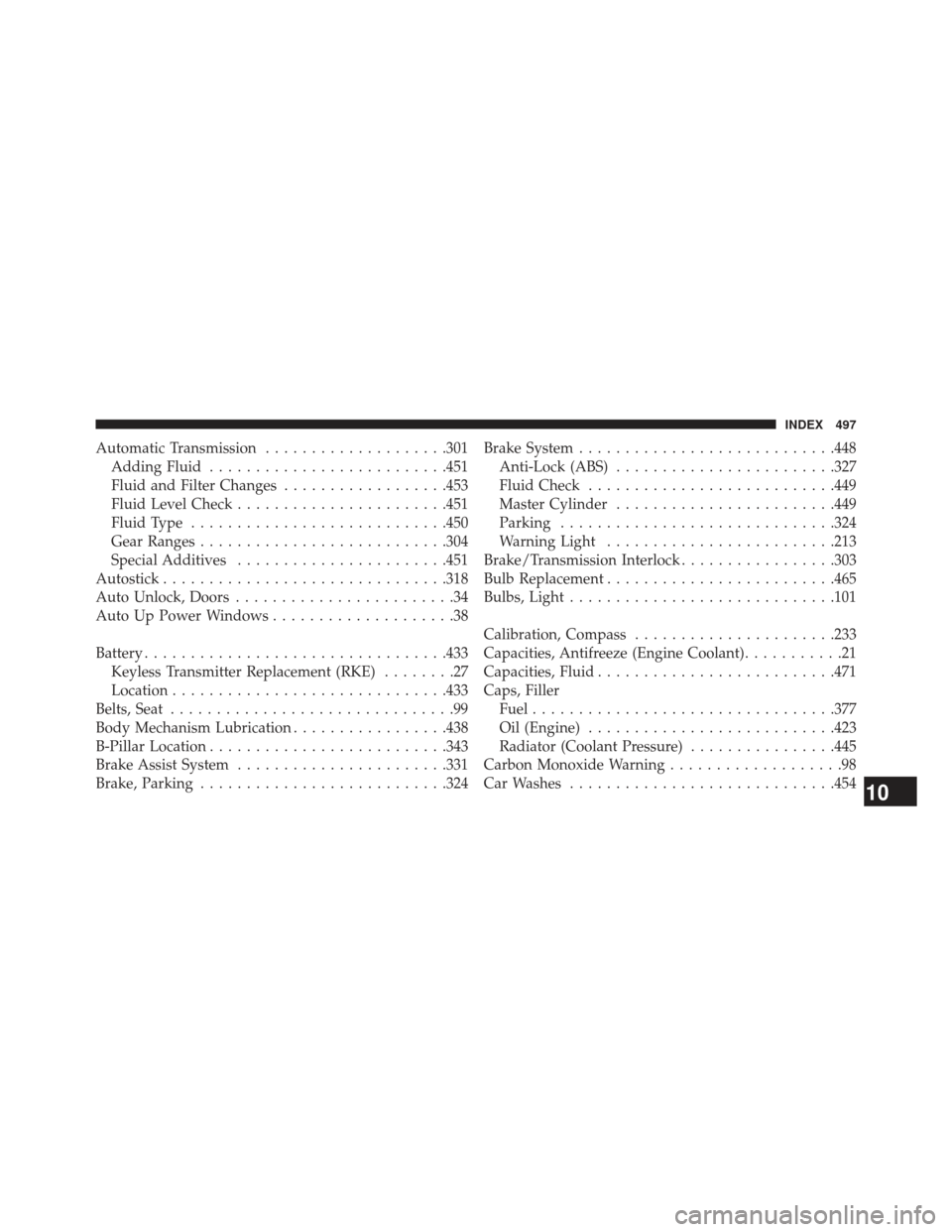
Automatic Transmission....................301
Adding Fluid ......................... .451
Fluid and Filter Changes ..................453
Fluid Level Check ...................... .451
Fluid Type ........................... .450
Gear Ranges .......................... .304
Special Additives ...................... .451
Autostick .............................. .318
Auto Unlock, Doors ........................34
Auto Up Power Windows ....................38
Battery ................................ .433
Keyless Transmitter Replacement (RKE) ........27
Location ............................. .433
Belts, Seat ...............................99
Body Mechanism Lubrication .................438
B-Pillar Location ......................... .343
Brake Assist System ...................... .331
Brake, Parking .......................... .324Brake System
........................... .448
Anti-Lock (ABS) ....................... .327
Fluid Check .......................... .449
Master Cylinder ....................... .449
Parking ............................. .324
Warning Light ........................ .213
Brake/Transmission Interlock .................303
Bulb Replacement ........................ .465
Bulbs, Light ............................ .101
Calibration, Compass ..................... .233
Capacities, Antifreeze (Engine Coolant) ...........21
Capacities, Fluid ......................... .471
Caps, Filler Fuel ................................ .377
Oil (Engine) .......................... .423
Radiator (Coolant Pressure) ................445
Carbon Monoxide Warning ...................98
Car Washes ............................ .454
10
INDEX 497
Page 500 of 517
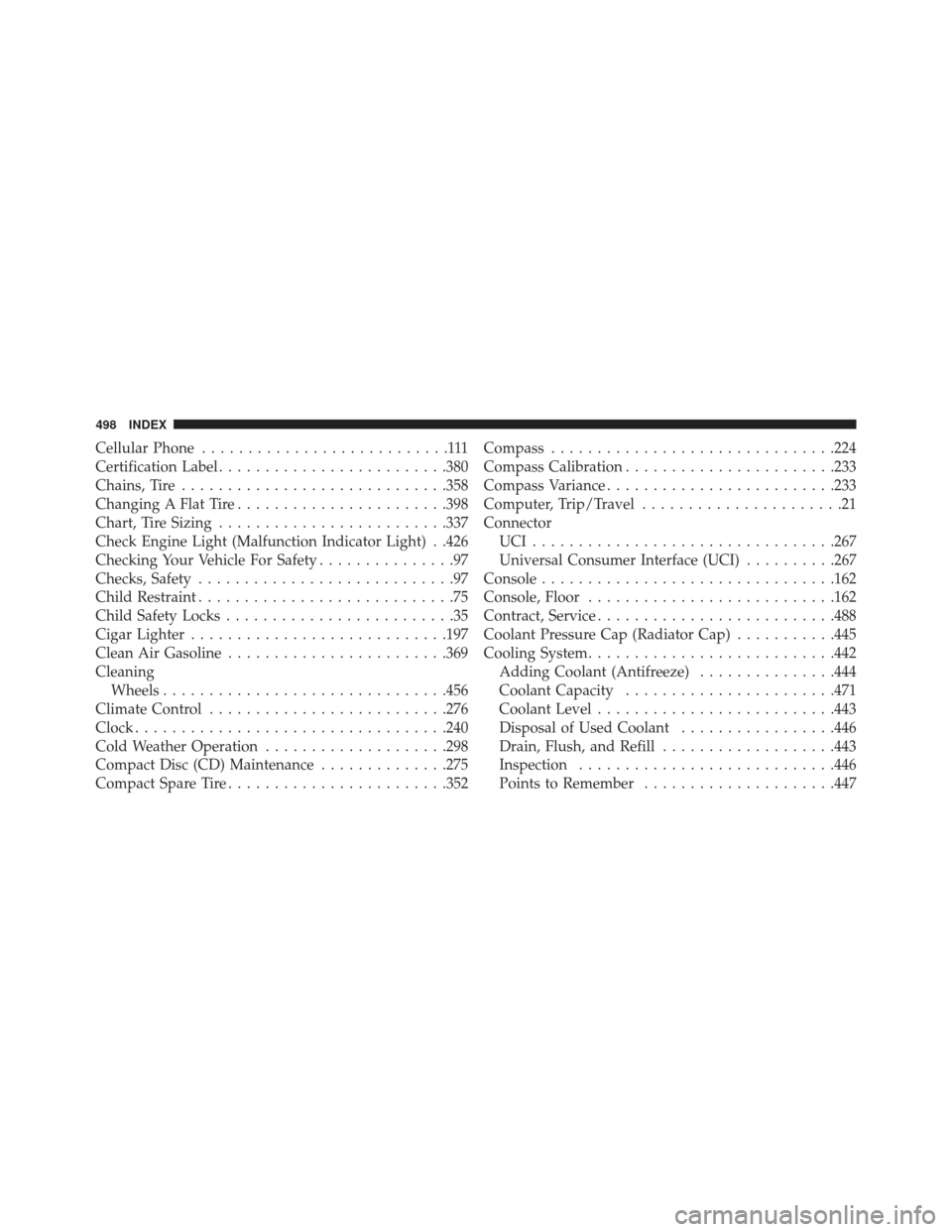
Cellular Phone...........................111
Certification Label ........................ .380
Chains, Tire ............................ .358
Changing A Flat Tire ...................... .398
Chart, Tire Sizing ........................ .337
Check Engine Light (Malfunction Indicator Light) . .426
Checking Your Vehicle For Safety ...............97
Checks, Safety ............................97
Child Restraint ............................75
Child Safety Locks .........................35
Cigar Lighter ........................... .197
Clean Air Gasoline ....................... .369
Cleaning Wheels .............................. .456
Climate Control ......................... .276
Clock ................................. .240
Cold Weather Operation ....................298
Compact Disc (CD) Maintenance ..............275
Compact Spare Tire ....................... .352Compass
.............................. .224
Compass Calibration ...................... .233
Compass Variance ........................ .233
Computer, Trip/Travel ......................21
Connector UCI................................ .267
Universal Consumer Interface (UCI) ..........267
Console ............................... .162
Console, Floor .......................... .162
Contract, Service ......................... .488
Coolant Pressure Cap (Radiator Cap) ...........445
Cooling System .......................... .442
Adding Coolant (Antifreeze) ...............444
Coolant Capacity ...................... .471
Coolant Level ......................... .443
Disposal of Used Coolant .................446
Drain, Flush, and Refill ...................443
Inspection ........................... .446
Points to Remember .....................447
498 INDEX
Page 502 of 517

Emergency, In Case ofJacking .............................. .398
Jump Starting ......................... .410
Towing ............................. .417
Emergency Trunk Release ....................42
Emission Control System Maintenance ..........426
Engine ................................ .423
Air Cleaner .......................... .433
Block Heater ......................... .300
Break-In Recommendations .................96
Checking Oil Level ..................... .429
Compartment ......................... .424
Compartment Identification ................424
Coolant (Antifreeze) .....................443
Cooling ............................. .442
Exhaust Gas Caution .....................98
Fails to Start .......................... .298
Flooded, Starting ...................... .298
Fuel Requirements ..................... .369Jump Starting
......................... .410
Oil................................. .429
Oil Change Interval ..................... .216
Oil Filler Cap ......................... .423
Oil Selection .......................... .430
Oil Synthetic ......................... .431
Overheating .......................... .396
Starting ............................. .296
Temperature Gauge ..................... .210
Engine Oil Viscosity ...................... .431
Engine Oil Viscosity Chart ...................431
Enhanced Accident Response Feature ............71
Entry System, Illuminated ....................21
Ethanol ............................... .370
Event Data Recorder ........................74
Exhaust Gas Caution ........................98
Exhaust System ...........................98
Exterior Lights .......................... .101
500 INDEX
Page 503 of 517
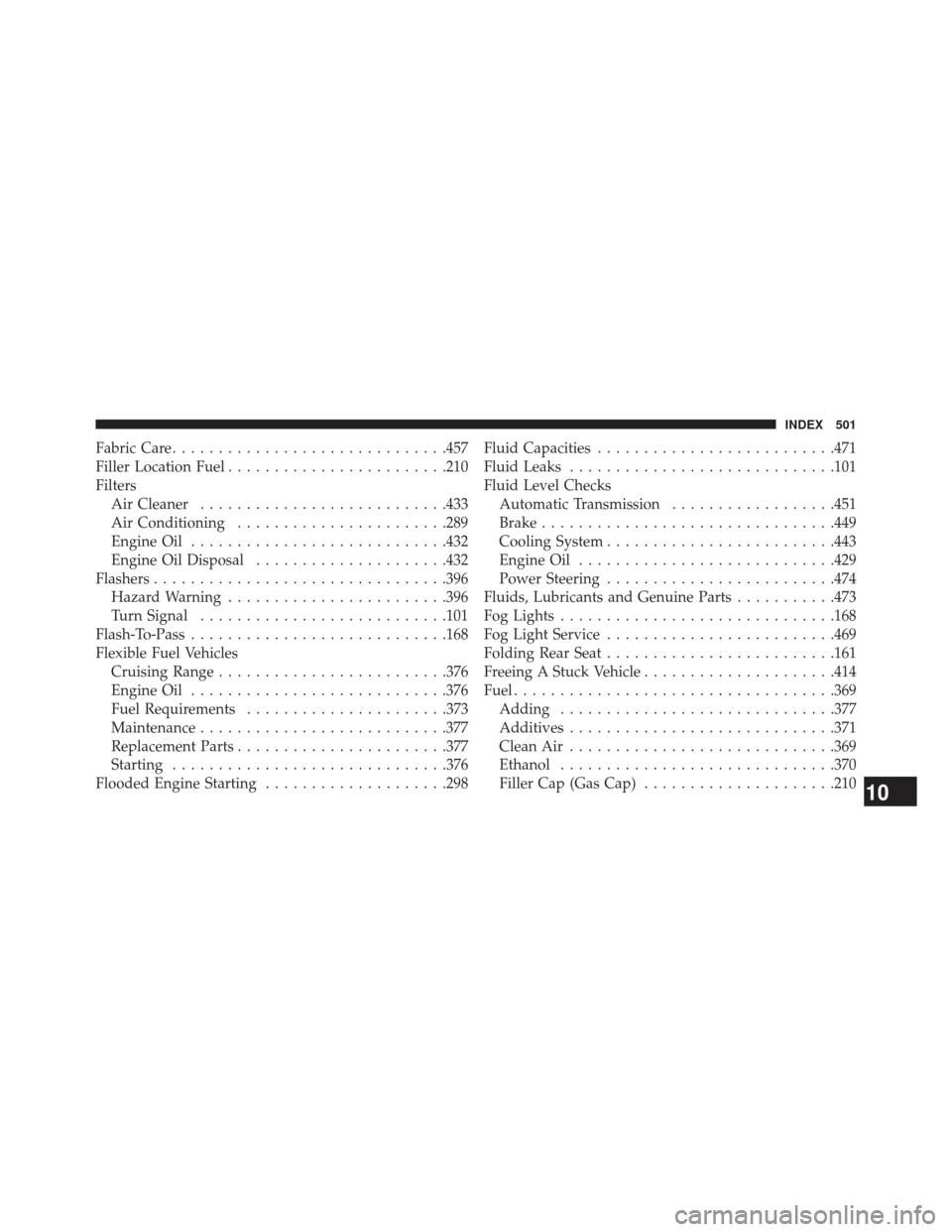
Fabric Care............................. .457
Filler Location Fuel ....................... .210
Filters Air Cleaner .......................... .433
Air Conditioning ...................... .289
Engine Oil ........................... .432
Engine Oil Disposal .....................432
Flashers ............................... .396
Hazard Warning ....................... .396
Turn Signal .......................... .101
Flash-To-Pass ........................... .168
Flexible Fuel Vehicles Cruising Range ........................ .376
Engine Oil ........................... .376
Fuel Requirements ..................... .373
Maintenance .......................... .377
Replacement Parts ...................... .377
Starting ............................. .376
Flooded Engine Starting ....................298 Fluid Capacities
......................... .471
Fluid Leaks ............................ .101
Fluid Level Checks Automatic Transmission ..................451
Brake ............................... .449
Cooling System ........................ .443
Engine Oil ........................... .429
Power Steering ........................ .474
Fluids, Lubricants and Genuine Parts ...........473
Fog Lights ............................. .168
Fog Light Service ........................ .469
Folding Rear Seat ........................ .161
Freeing A Stuck Vehicle .....................414
Fuel .................................. .369
Adding ............................. .377
Additives ............................ .371
Clean Air ............................ .369
Ethanol ............................. .370
Filler
Cap (Gas Cap) .....................210
10
INDEX 501
Page 507 of 517
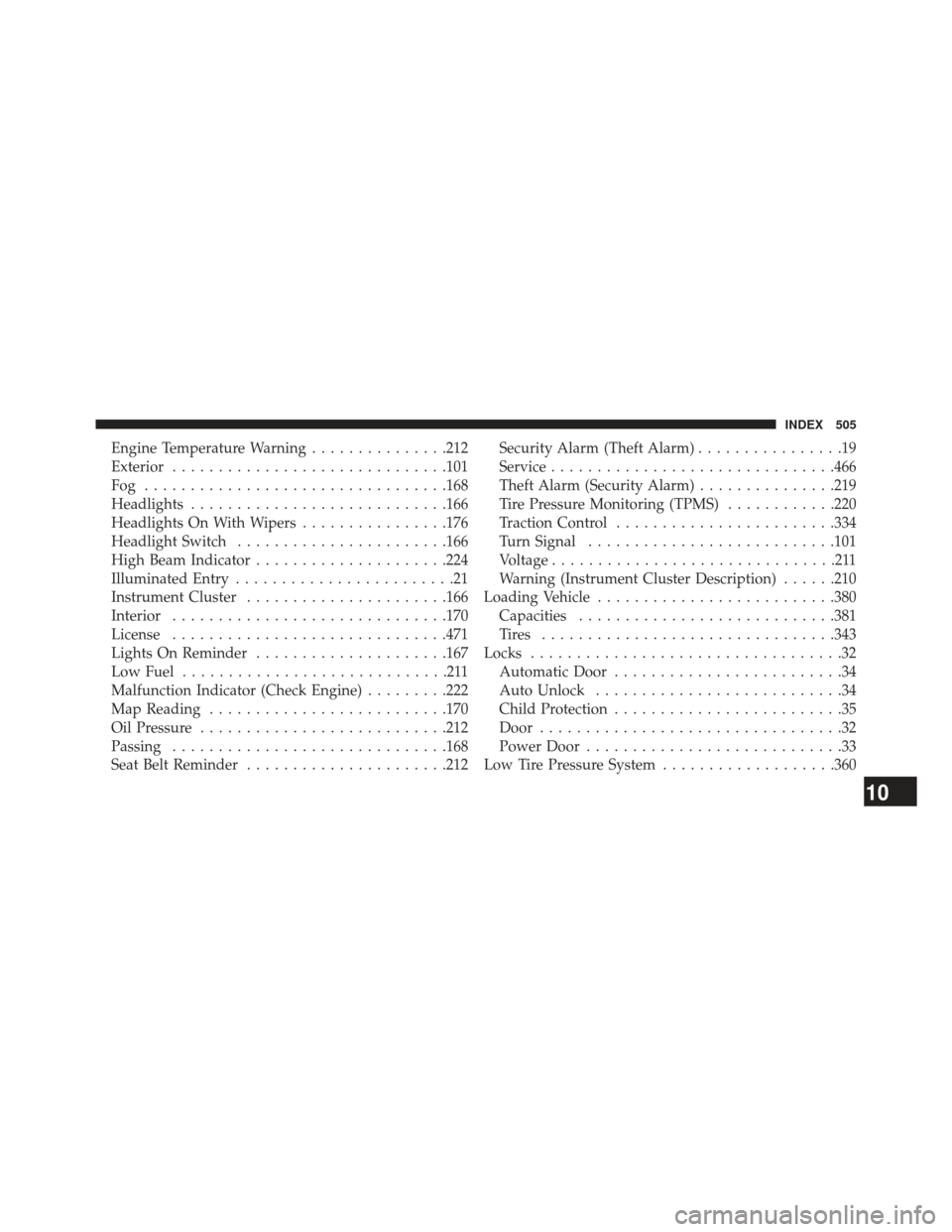
Engine Temperature Warning...............212
Exterior ............................. .101
Fog ................................ .168
Headlights ........................... .166
Headlights On With Wipers ................176
Headlight Switch ...................... .166
High Beam Indicator .....................224
Illuminated Entry ........................21
Instrument Cluster ..................... .166
Interior ............................. .170
License ............................. .471
Lights On Reminder .....................167
Low Fuel .............................211
Malfunction Indicator (Check Engine) .........222
Map Reading ......................... .170
Oil Pressure .......................... .212
Passing ............................. .168
Seat Belt Reminder ..................... .212Security Alarm (Theft Alarm)
................19
Service .............................. .466
Theft Alarm (Security Alarm) ...............219
Tire Pressure Monitoring (TPMS) ............220
Traction Control ....................... .334
Turn Signal .......................... .101
Voltage ...............................211
Warning (Instrument Cluster Description) ......210
Loading Vehicle ......................... .380
Capacities ........................... .381
Tires ............................... .343
Locks ..................................32
Automatic Door .........................34
Auto Unlock ...........................34
Child Protection .........................35
Door .................................32
Power Door ............................33
Low Tire Pressure System ...................360
10
INDEX 505